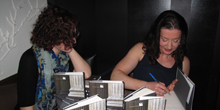Lianne McTavish's new book Defining the Modern Museum (published by the University of Toronto Press) explores the history of the New Brunswick Museum in Saint John, as well as other organizations in Canada, the United States, and Europe, to challenge assumptions about what a museum is, what function it serves, and who partakes in its ongoing formation. In particular, McTavish focuses on the culture of exchange 'between museums,' linking economic, educational, and other interests. She has undertaken extensive archival research in order to study such themes as the commodification of museums, museums and entertainment, and the professionalization of museum workers, which are currently debated in scholarship devoted to critical museum theory and museum practice.
One of the clichés of the museum as an institution is the image of a neoclassical building, with a fossilized skeleton in the lobby and themed galleries to the sides. But this cliché is more at home in a New Yorker cartoon than in reality. The New Brunswick Museum, Canada's oldest continuing public museum, foils all attempts to define it according to received notions. Neither the epitome of nineteenth century ethnography, anthropology and classification, all in the service of colonialism and imperialism, nor the capricious collecting and display of the seventeenth century Wunderkammer, the cabinet of curiosities, it nevertheless is rife with ideology - only not the ideology one expects.
Each chapter examines a particular theme running through the museum's history: its formation through private donations and its role in what was once a major port city; its relationship with schools through educational and outreach programs; its relationship to business and the economy, government agencies, and libraries; the contested role of women, who at one time were not allowed to be members but nevertheless staked a claim in the museum space; and the museum's professionalization since the 50s. The book's subtitle, A Case Study of the Challenges of Exchange, is perhaps misleading, as this is not merely a local history, but deals with a museum that has a particularly significant place in Canada and North America.
McTavish has been a full professor in the History of Art, Design and Visual Culture at the University of Alberta since 2007. She previously taught at the University of New Brunswick and the University of Western Ontario.
